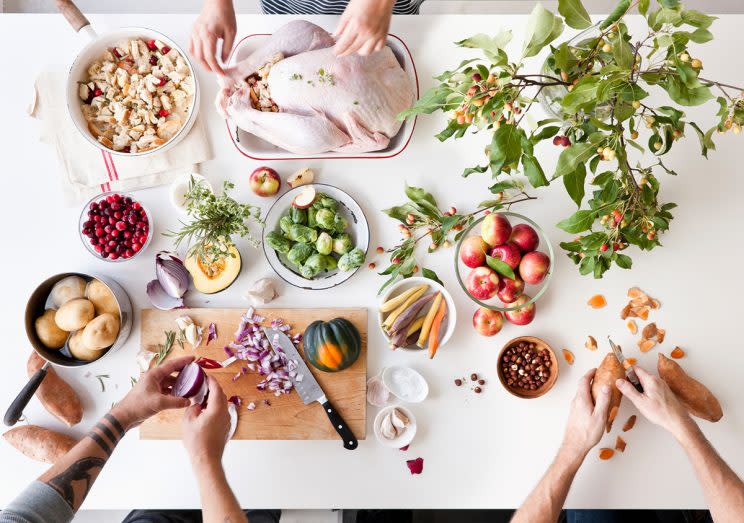Your Thanksgiving Healthy Eating Survival Guide

Thanksgiving is here. It’s the one time of year that we can stuff ourselves to the brim and call it normal, which we love. And while we’re all for indulging, it can mean a lot of pain, gurgling, bloating, and worse. We teamed up with holistic nutritionist and wellness coach Dorit Jaffe of Whole Healthy Glow to help you out, because when it comes to Thanksgiving, you can have your cake and eat it, too. From the inherently healthy dishes you should heap onto your plate to the ones you just need a taste of, here’s your guide to navigating the table without feeling like an overstuffed turkey yourself.
A photo posted by Dorit Jaffe (@wholehealthyglow) on Nov 28, 2015 at 8:06am PST
Keep these tips in mind while eating to finish your meal feeling satisfied and nourished, not bloated and guilty:
Drink warm lemon water or ginger tea with lemon juice on an empty stomach before your meal, and after you finish eating. This will boost your metabolism, de-bloat, prevent indigestion, and help to cleanse your system pre- and post-meal.
Eat slowly. Chewing your food well will allow your body to absorb all the nutrients and will break down your food before it reaches your stomach, which will help to prevent bloating. Eating slowly also will have you feeling full from less food. When you eat quickly, you don’t realize how much you’ve eaten and tend to eat more than you need.
Relax while eating. When eating with a big group of people, we can get excited or stressed, particularly when certain conversations arise (we’ve all had those heated moments with family across the table). When your body is stressed, it releases cortisol and goes into fight or flight mode, shutting down your body’s ability to properly digest.
Eat in moderation. Don’t be afraid to indulge in your favorite dishes that you don’t normally eat. However, remember that everything is fine to eat in moderation. Don’t force more food down once you feel satisfied. Divide your plate with ½ vegetables, ¼ starch, and ¼ protein. For dessert, try to have a small slice of pie or two slivers of different pies.
A photo posted by Dorit Jaffe (@wholehealthyglow) on Nov 26, 2015 at 4:08pm PST
A lot of traditional Thanksgiving recipes can be heavy on oil, butter and sugar. Try to take a smaller serving of these traditional meals:
Deep fried turkey has added saturated fat. Opt for roasted turkey instead.
Candied yams contain a lot of added sugar and oil. Yams are sweet enough on their own, and they really don’t need to be drenched in sugar or butter to add any flavor to them.
Mashed potatoes can be healthy, but oftentimes have heavy doses of butter, cheese, or bacon in the recipe. This adds a lot of extra calories that will make you feel groggy. If you’re making mashed potatoes, use grass-fed butter and almond milk instead of heavy cream or dairy milk for a lighter option.
Pecan pie is a Thanksgiving classic, but nuts should be eaten in moderation because they contain lots of carbohydrates and calories. A little goes a long way, so if you feel the need to reach for this dessert, take a small piece. This can add 200 to 300 calories to your meal, and your body can only digest so much food in one sitting.
A photo posted by Dorit Jaffe (@wholehealthyglow) on Nov 19, 2016 at 11:37am PST
Lots of classic Thanksgiving dishes are naturally healthy. Load your plate with these to feel the best post-meal:
Butternut squash soup is naturally sweet always delicious. This squash is rich in potassium, and vitamin B6, which is essential for proper function of your bone and nervous system.
Brussels sprout side dishes are extremely healthy, especially when they’re roasted. These green gems are rich in vitamin C and a good source of protein, iron, and potassium, which can be hard to get if you’re limiting your meat intake.
Pasture-raised roasted turkey is rich in protein and a vital mineral called selenium, which helps to prevent illness and aids in proper immune system function. Dark meat fans are in luck — this meat typically contains more vitamins and minerals than the white meat. Turkey contains vitamins B-6 and B-12, niacin, choline, selenium and zinc.
Roasted sweet potatoes are also a great Thanksgiving side to prepare. Simply letting the flavors of the vegetables shine through will provide plenty of flavor. Sweet potatoes are low glycemic and rich in vitamins A and B, thiamin, niacin, riboflavin, and are also high in carotenoids.
By Dorit Jaffe as told to Devon Kelley
Let’s keep in touch! Follow Yahoo Beauty on Facebook, Twitter, Instagram, and Pinterest.

